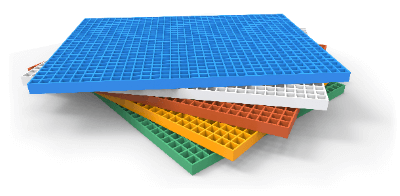What Is Fiberglass Reinforced Plastic (FRP) Grating?
 Fiberglass Reinforced Plastic (FRP) Grating is a grating made of FRP. It is a relatively new material and is mainly used for buildings.
Fiberglass Reinforced Plastic (FRP) Grating is a grating made of FRP. It is a relatively new material and is mainly used for buildings.
FRP is an acronym for “Fiber Reinforced Plastics”. It is a material that combines plastic resin and glass fiber, and its strength is comparable to that of metal, even though it is plastic. Since it does not corrode, it is widely used in factories and outdoors where corrosive substances are handled.
Uses of Fiberglass Reinforced Plastic (FRP) Grating
FRP Grating is used in various places as a construction material. In daily life, they can be found in aquarium corridors and drain covers. This is because corrosion by seawater will occur if grating made of metal material is used.
In industrial applications, grating is used in flue gas desulfurization plants. FRP is also used for flue gas desulfurization plants, and FRP material is very useful for flue gas desulfurization plants.
Principle of Fiberglass Reinforced Plastic (FRP) Grating
FRP is reinforced by mixing glass fiber with plastic. The strength is increased by mixing glass fiber, which has a high elasticity rate and is strong, with plastic, which has a low elasticity rate and is prone to cracking.
FRP Grating is lighter than metal grating. Specifically, its specific gravity is about 25% that of cast iron and 60% that of aluminum, and it has excellent corrosion resistance. When utilized as a construction material, FRP grating is easier to process than metal grating. However, being a mixture of plastic and glass fiber, it is difficult to recycle or dispose of.
FRP Grating can be colored either by surface coating or by adding pigments during the molding process. Mixing the pigments during the molding process is advantageous because it prevents the surface from peeling off.
Use of Fiberglass Reinforced Plastic (FRP) Grating as Flooring Material
FRP Grating is a lightweight material with excellent corrosion resistance. Therefore, FRP grating is suitable for flooring in corrosive environments such as chemical plants and ships where load reduction is required. FRP Grating with a non-slip shape can also help prevent pedestrians from falling.
FRP Gratings have high lighting performance, allowing light to reach the first floor through windows on the second floor of a house. It is also possible to change the impression by changing the color. When used as a flooring material, it may cause pain standing barefoot for long periods of time. For places where people stand for long periods of time, polycarbonate is placed on top of the grating to distribute the weight.
FRP Grating can also be used for bridge floor panels, stairs, etc. because it is an insulator, allows radio waves to pass through, and can be easily colored.
Other Information on Fiberglass Reinforced Plastic (FRP) Grating
1. Strength of Fiberglass Reinforced Plastic (FRP) Grating
FRP Grating can withstand up to 350 kg per square meter, and its service life is estimated to be 20~30 years based on the results of outdoor exposure and accelerated exposure tests. Yellowing of the exterior due to ultraviolet rays will occur after 5~10 years of use. This yellowing can be improved by painting.
FRP Grating is impact resistant to full impact. However, there are limitations on impact resistance due to puncture and falling load, so it is necessary to check the information of the manufacturing manufacturer.
The heat resistance of general FRP gratings are about 65~80℃, which is not as high as that of metal. FRP Grating made of a special resin should be used for use under high temperatures.
2. Outdoor Use of Fiberglass Reinforced Plastic (FRP) Grating
FRP Gratings have high weather resistance, and their strength hardly deteriorates due to temperature changes. Therefore, they can be used outdoors. Examples of outdoor applications include balcony flooring, plant walkways, stair treads, drain covers, and exterior wall partitions.